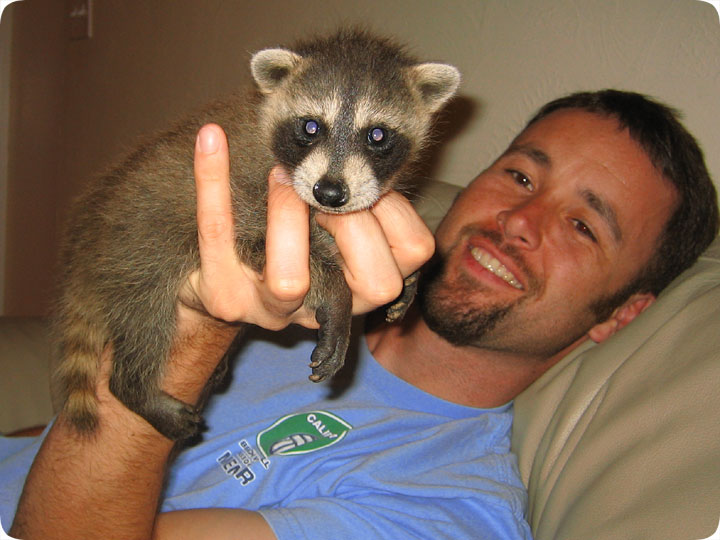-
info@aaanimalcontrol.com
Call us for help in your town
Humane Wildlife Education
Little Raccoon

04.02.2006 - No real point to this blog post except to show off this cute photo of Sean with an adorable little raccoon. It was one of a litter of baby raccoons,
perhaps six weeks old, that we removed from an attic earlier today. We are keeping them in a box, and feeding them kitty formula, and then tomorrow we will bring them to
Lee the wildlife rehabber, and she will raise them until they are large enough to fend for themselves.
Raccoons like this one are almost hypnotic in their captivating
power to leave their handlers entranced for hours on end, with their little black masks and little cooing and chirping sounds. I almost forget that they grow up into big
raccoons that tear open roofs. It is pretty cool that raccoons, both young and old, tend to be fairly fearless.
Little raccoon, so adorable, perched between Sean's
fingers. Little raccoon it wouldn't be horrible, if you there forever lingered. I can gaze into your purple eyes, your claw tipped hands of unusual size, your ringy
tail, your little black nose, you never fail to inspire prose, you little raccoon, so very sweet, you'll make a sandwich of raccoon meat.
We specialize in nuisance wildlife control - this is the field of removing unwanted wildlife from homes and property, and solving conflicts between people and wild animals. From home inspections to preventative repairs, wildlife trapping, attic cleanups and more, we solve
critter problems with professional expertise. Call me, David, or click on the below link to find any one of hundreds of wildlife trappers in every city and town in the US.
Do it yourself: Visit my How To Get Rid of Raccoons page for tips and advice.
Get professional help: Visit my Nationwide Pro Directory of wildlife removal experts.
For more wildlife stories, click my Wildlife Blog
or click my below banner to hire a local trapper.
Baby raccoons look similar to adults, only that they are a lot smaller with giant mouths. Raccoons generally give birth to their kits in late spring after a gestation period of about 60 to 73 days. Newborns do not open their eyes and ears until after about three weeks. During this period, they rely entirely on breast milk and only sleep and eat. Between 4 to 6 weeks, their guard (longer) hairs begin to grow and they learn to grip with their feet.
At about 6 to 8 weeks, their teeth begin to grow. Weaning is completed after 8 to 10 weeks. At this point, they can eat adult food like chicks and mice, and they begin to explore around the nest. Typically, they stay with their mother for about 10 to 12 months before they become fully independent.
Finding a baby raccoon that looks abandoned strikes a deep chord within us. They look cute and we do not want to see them suffer. However, what is the appropriate way to handle such a situation?
Make Sure It's Truly Abandoned or Orphaned
If you find a baby raccoon, there's a pretty strong chance the mother just stepped out to forage for food. Similarly, she might be in the process of moving her kits to a new den. That's why it's best to stand down.
The simple truth is that no amount of care you render can come close to what its mother can offer. You can feed a baby raccoon but you cannot teach it basic survival skills.
Observe It
Is the baby injured or dehydrated? Is its body covered with flies, fleas, or ants? Is it crying incessantly? This might be signs that it's truly been abandoned. The truth is that during wildlife removal, mothers are sometimes separated from their kits. It's also possible that she dies from a predator attack or disease.
To clear all doubt, leave it alone till the next day just to see if its mother comes back since they are nocturnal creatures. Baby raccoons are resilient and are built for survival. If it's still abandoned, then it's time to take some clear actions.
Contact a Wildlife Rehabilitation Center
Once you're certain that it's abandoned or orphaned, you should contact a local wildlife rehabilitation center.
In the meantime, it's important that you avoid direct contact with the baby. A sick looking baby might have rabies or any other disease and you do not want it to get transmitted to you. They can also bite or scratch if they feel threatened.
You should wear gloves and put the baby raccoon in a warm box. DO NOT FEED THEM! Giving them the wrong food can kill them. Thereafter, place the box near a heat source to maintain its temperature. This is particularly important if it's cold. However, be careful because too high of temperatures can also kill it.
Once the professionals arrive, they know how to handle the situation. On the other hand, you might be required to take the baby to a licensed rehabilitator.
dConclusion
Although baby raccoons are cute, you should make sure they're abandoned before helping out. In most cases, their mother has just left to find food. And even if you're certain that they are abandoned, do not attempt to rear the kits on your own. They are wild animals and not pets. Instead, contact a wildlife rehabilitation center as they're better equipped to deal with it.




















